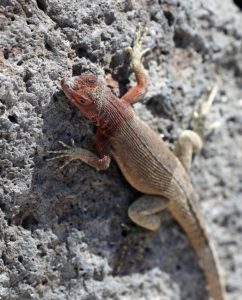The small, grayish brown reptile is everywhere along the islands’ trails, either perching motionless on a rock or darting into the brush. Their behavior reminds me of the brown anole lizard, with males climbing to a lofty perch before doing “push ups” to attract potential mates.
As with many other genera, each island has only one species. Across the Galapagos there are seven, but I came across only three. They vary considerably in color and pattern between species, between sexes and even within species of the same sex. Males are larger, have more of a distinctive pattern, a crest along the ridge of their backs and a dark red or black patch on their throats.On San Cristobal, M. bivitattus generally has alternating dark and light stripes along the length of its body and seemed to be smaller than the other species. Overall, they were paler than the others, too.
On Espanola, M. delanonis males are spotted black with a black throat patch and a reddish tint toward the tail. Females have more of a solid tone with a red cowl.
M. albemarlensis, which I saw on Santa Cruz, is the most common species, found on about 10 islands. It has a combination of dark spots in a striped pattern, though not as distinct in either respect as the other two.
They eat mostly insects, though I saw one chewing on vegetation. From the other end of the food web a mockingbird swooped down and grabbed one small lava lizard while I was admiring it.

